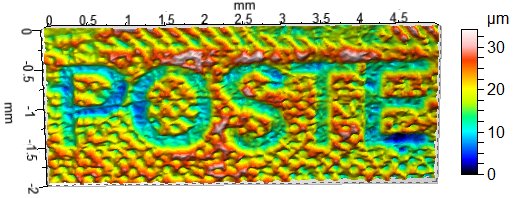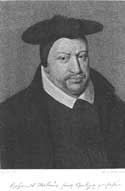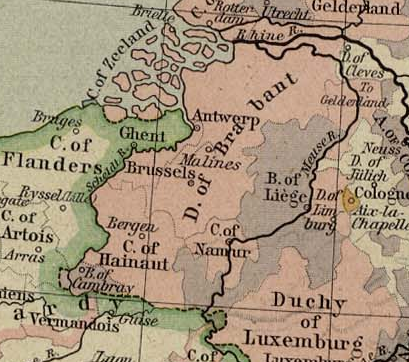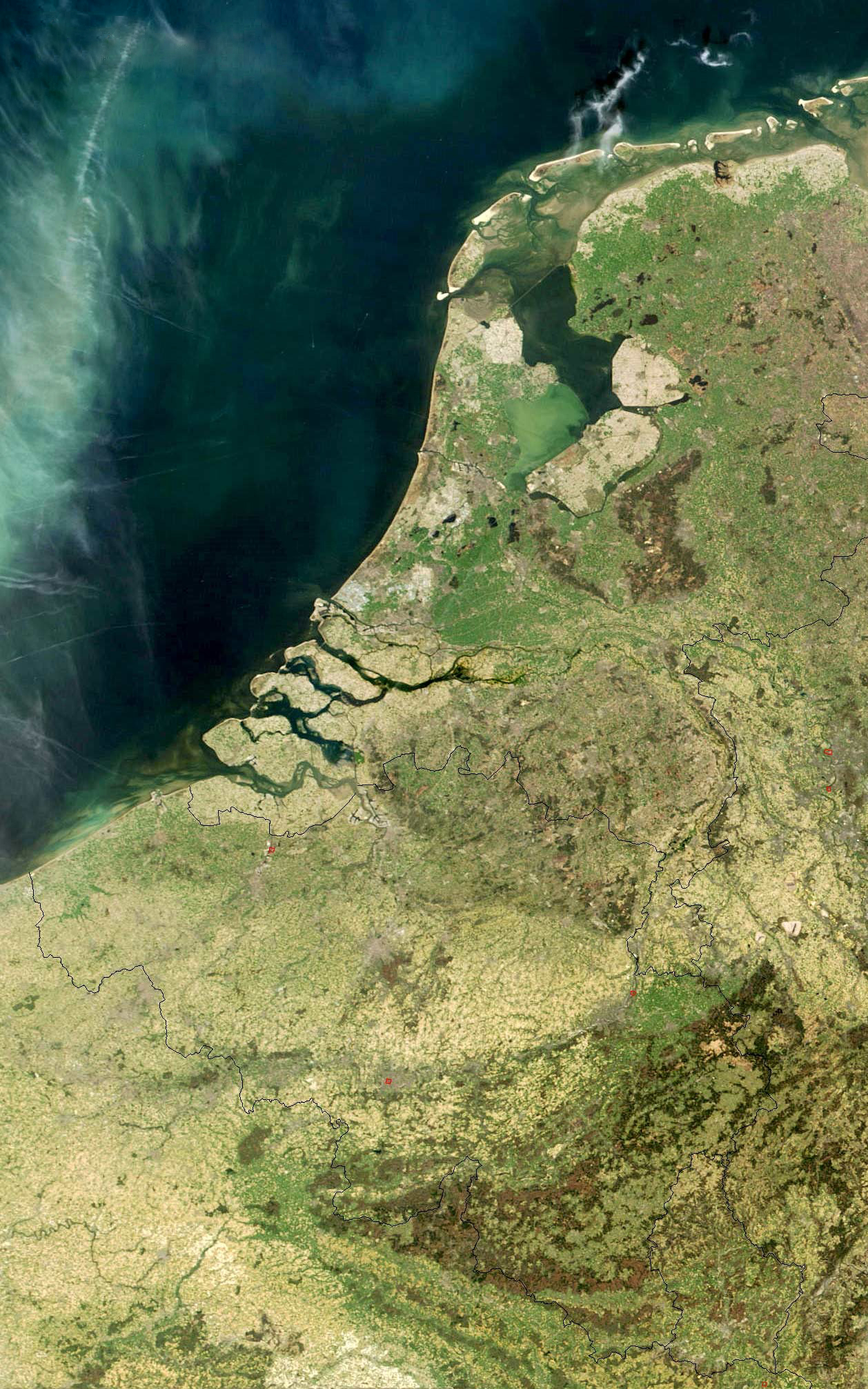|
Philippe De L'Espinoy
Philippe de L'Espinoy (1552–1633) of Ghent was a historian, genealogist and heraldist of the Low Countries. He served as the commander of a company of Walloon infantry during the reign of Philip II of Spain. He gave up the military career to devote full-time to genealogical studies that led to the publication of the important volume in 1631, which was partly financed by the magistrate of the city of Ghent. The work contains the genealogical history of the counts of Flanders with a description of the aforesaid country. The number of illustrations in this book counts to a hefty 1,121 escutcheons, standards and seals of armorial bearings on wood, besides 58 copperplate illustrations. There is a full-page engraving with the arms of the Infante Isabelle and a great double-spread engraving representing an assembly of the dignitaries of the Flanders. The French heraldist Imbert de la Phalecque and his Italian counterpart Goffredo di Crollanza claim that the work of Philippe de l'Espi ... [...More Info...] [...Related Items...] OR: [Wikipedia] [Google] [Baidu] |
Ghent
Ghent ( nl, Gent ; french: Gand ; traditional English: Gaunt) is a city and a Municipalities of Belgium, municipality in the Flemish Region of Belgium. It is the capital and largest city of the East Flanders province, and the third largest in the country, exceeded in size only by Brussels and Antwerp. It is a Port of Ghent, port and Ghent University, university city. The city originally started as a settlement at the confluence of the Rivers Scheldt and Leie and in the Late Middle Ages became one of the largest and richest cities of northern Europe, with some 50,000 people in 1300. The municipality comprises the city of Ghent proper and the surrounding suburbs of Afsnee, Desteldonk, Drongen, Gentbrugge, Ledeberg, Mariakerke (East Flanders), Mariakerke, Mendonk, Oostakker, Sint-Amandsberg, Sint-Denijs-Westrem, Sint-Kruis-Winkel, Wondelgem and Zwijnaarde. With 262,219 inhabitants at the beginning of 2019, Ghent is Belgium's second largest municipality by number of inhabitants ... [...More Info...] [...Related Items...] OR: [Wikipedia] [Google] [Baidu] |
Intaglio Printing
Intaglio ( ; ) is the family of printing and printmaking techniques in which the image is incised into a surface and the incised line or sunken area holds the ink. It is the direct opposite of a relief print where the parts of the matrix that make the image stand ''above'' the main surface. Normally, copper or in recent times zinc sheets, called plates, are used as a surface or matrix, and the incisions are created by etching, engraving, drypoint, aquatint or mezzotint, often in combination. Collagraphs may also be printed as intaglio plates. After the decline of the main relief technique of woodcut around 1550, the intaglio techniques dominated both artistic printmaking as well as most types of illustration and popular prints until the mid 19th century. Process In intaglio printing, the lines to be printed are cut into a metal (e.g. copper) plate by means either of a cutting tool called a burin, held in the hand – in which case the process is called ''engraving''; or t ... [...More Info...] [...Related Items...] OR: [Wikipedia] [Google] [Baidu] |
Molanus
Joannes Molanus (1533–1585), often cited simply as Molanus, is the Latinized name of Jan Vermeulen or Van der Meulen, an influential Counter Reformation Catholic theologian of Louvain University, where he was Professor of Theology, and Rector from 1578. Born at Lille (a city in the County of Flanders, then under Habsburg rule), he was a priest and canon of St. Peter's Church, Leuven, where he died. He wrote numerous books, several only published posthumously. He is best known for his ''De Picturis et Imaginibus Sacris, pro vero earum usu contra abusus'' ("Treatise on Sacred Images"). This was published in 1570, four years after the Iconoclastic Fury had swept through the Low Countries, and it defended the production and use of devotional images, but enforcing the restrictions of the Council of Trent, as he interpreted them, in a brutally polemical fashion, which was very influential. Five further, enlarged, editions of this appeared between 1594 and 1771, and a modern Fre ... [...More Info...] [...Related Items...] OR: [Wikipedia] [Google] [Baidu] |
Jan Baptist Zangrius
Jan Baptist Zangrius (died 1606 in Leuven) was a Flemish engraver, publisher, typographer and bookseller. His name is mostly spelled as Johannes Baptista Zangrius, but is also known as de Sanger, de Zangre, Zangre, and Zangré. Biographical data He was active in Leuven between 1595 and 1606 and by all probability he was a relative of the publishers and typographists Petrus (1559–1623) and Philippus Zangrius (1585–1610). In 1601, Zangrius engraved the portraits of Infante Isabella, her husband archduke Albrecht Habsburg, governor of the Low Countries, and Justus Lipsius. These engravings were also part of his 1602 (or 1605) work titled ''Album Amicorum'' containing 67 engravings, namely 46 womanly costumes and armorial cartouches, 9 small and 11 bigger armorial engravings. It is one of the earliest examples of heraldic pavilions (by all probability after Jean-Jacques Boissard). The small armorial shields are empty. The womanly costumes were engraved after the tables of Ju ... [...More Info...] [...Related Items...] OR: [Wikipedia] [Google] [Baidu] |
Duchy Of Brabant
The Duchy of Brabant was a State of the Holy Roman Empire established in 1183. It developed from the Landgraviate of Brabant and formed the heart of the historic Low Countries, part of the Burgundian Netherlands from 1430 and of the Habsburg Netherlands from 1482, until it was partitioned after the Dutch revolt. Present-day North Brabant (''Noord-Brabant'') was ceded to the Generality Lands of the Dutch Republic according to the 1648 Peace of Westphalia, while the reduced duchy remained part of the Habsburg Netherlands until it was conquered by French Revolutionary forces in 1794, which was recognized by treaty in 1797. Today all the duchy's former territories, apart from exclaves, are in Belgium except for the Dutch province of North Brabant. Geography The Duchy of Brabant (adjective: '' Brabantian'' or '' Brabantine'') was historically divided into four parts, each with its own capital. The four capitals were Leuven, Brussels, Antwerp and 's-Hertogenbosch. Before ' ... [...More Info...] [...Related Items...] OR: [Wikipedia] [Google] [Baidu] |
County Of Flanders
The County of Flanders was a historic territory in the Low Countries. From 862 onwards, the counts of Flanders were among the original twelve peers of the Kingdom of France. For centuries, their estates around the cities of Ghent, Bruges and Ypres formed one of the most affluent regions in Europe. Up to 1477, the area under French suzerainty was west of the Scheldt and was called "Royal Flanders" (Dutch: ''Kroon-Vlaanderen'', French: ''Flandre royale''). Aside from this, the counts, from the 11th century onward, held land east of the river as a fief of the Holy Roman Empire: "Imperial Flanders" (''Rijks-Vlaanderen'' or ''Flandre impériale''). Part of the Burgundian Netherlands from 1384, which had a complex relation with France, the whole county fell to the Empire after the Peace of Madrid in 1526 and the Peace of the Ladies in 1529. Having already regained much, by 1795, the rest – within the Austrian Netherlands – was acquired likewise by France under the Fren ... [...More Info...] [...Related Items...] OR: [Wikipedia] [Google] [Baidu] |
Hatching System
Hatching (sometimes called ''hachure'', from the French word) is a conventional system for monochrome denotation of heraldic armory, whereby the tinctures (colours) are represented by dots and lines. This technique is employed in cases where colours, for either aesthetic, practical or economic reasons are not reproduced – e.g. on surfaces such as woodcuts or engravings, seals and coins. Several systems of hatchings were developed during the Renaissance as an alternative to tricking, the earlier method of indicating heraldic tinctures by use of written abbreviations. The present day hatching system was developed during the 1630s by Silvester Petra Sancta and Marcus Vulson de la Colombière. Some earlier hatching methods were also developed, but did not come into wide use. Tricking is an alternative method which has the same purpose as hatching. Conventional system Genesis Hatching developed as a method of screening used by Renaissance painters. For copperplate engrave ... [...More Info...] [...Related Items...] OR: [Wikipedia] [Google] [Baidu] |
Gules
In heraldry, gules () is the tincture with the colour red. It is one of the class of five dark tinctures called "colours", the others being azure (blue), sable (black), vert (green) and purpure (purple). In engraving, it is sometimes depicted by hatching of vertical lines. In tricking—abbreviations written in areas to indicate their tinctures—it is marked with gu.. Etymology The term ''gules'' derives from the Old French word , literally "throats" (related to the English '' gullet''; modern French ), but also used to refer to a fur neckpiece, usually made of red fur. A.C. Fox-Davies states that the term originates from the Persian word , "rose", but according to Brault, there is no evidence to support this derivation. Examples Gules is the most widely used heraldic tincture. Through the sixteenth century, nearly half of all noble coats of arms in Poland had a field gules with one or more argent charges on them. Examples of coats of arms consisting of purely a ... [...More Info...] [...Related Items...] OR: [Wikipedia] [Google] [Baidu] |
Infante
''Infante'' (, ; f. ''infanta''), also anglicised as Infant or translated as Prince, is the title and rank given in the Iberian kingdoms of Spain (including the predecessor kingdoms of Aragon, Castile, Navarre, and León) and Portugal to the sons and daughters (''infantas'') of the king, regardless of age, sometimes with the exception of the heir apparent or heir presumptive to the throne who usually bears a unique princely or ducal title.de Badts de Cugnac, Chantal. Coutant de Saisseval, Guy. ''Le Petit Gotha''. Nouvelle Imprimerie Laballery, Paris 2002, p. 303, 364-369, 398, 406, 740-742, 756-758 (French) A woman married to a male ''infante'' was accorded the title of ''infanta'' if the marriage was dynastically approved (e.g., Princess Alicia of Bourbon-Parma), although since 1987 this is no longer automatically the case in Spain (e.g., Princess Anne d'Orléans). Husbands of born ''infantas'' did not obtain the title of ''infante'' through marriage (unlike most hered ... [...More Info...] [...Related Items...] OR: [Wikipedia] [Google] [Baidu] |
Armorial Bearings
A coat of arms is a heraldic visual design on an escutcheon (i.e., shield), surcoat, or tabard (the latter two being outer garments). The coat of arms on an escutcheon forms the central element of the full heraldic achievement, which in its whole consists of a shield, supporters, a crest, and a motto. A coat of arms is traditionally unique to an individual person, family, state, organization, school or corporation. The term itself of 'coat of arms' describing in modern times just the heraldic design, originates from the description of the entire medieval chainmail 'surcoat' garment used in combat or preparation for the latter. Rolls of arms are collections of many coats of arms, and since the early Modern Age centuries, they have been a source of information for public showing and tracing the membership of a noble family, and therefore its genealogy across time. History Heraldic designs came into general use among European nobility in the 12th century. Systemat ... [...More Info...] [...Related Items...] OR: [Wikipedia] [Google] [Baidu] |
Low Countries
The term Low Countries, also known as the Low Lands ( nl, de Lage Landen, french: les Pays-Bas, lb, déi Niddereg Lännereien) and historically called the Netherlands ( nl, de Nederlanden), Flanders, or Belgica, is a coastal lowland region in Northwestern Europe forming the lower basin of the Rhine–Meuse–Scheldt delta and consisting of three countries: Belgium, the Netherlands and Luxembourg. Geographically and historically, the area also includes parts of France and Germany such as the French Flanders and the German regions of East Frisia and Cleves. During the Middle Ages, the Low Countries were divided into numerous semi-independent principalities. Historically, the regions without access to the sea linked themselves politically and economically to those with access to form various unions of ports and hinterland, stretching inland as far as parts of the German Rhineland. Because of this, nowadays not only physically low-altitude areas, but also some hilly or elevated ... [...More Info...] [...Related Items...] OR: [Wikipedia] [Google] [Baidu] |
Seal (device)
A seal is a device for making an impression in Sealing wax, wax, clay, paper, or some other medium, including an embossment on paper, and is also the impression thus made. The original purpose was to authenticate a document, or to prevent interference with a package or envelope by applying a seal which had to be broken to open the container (hence the modern English verb "to seal", which implies secure closing without an actual wax seal). The seal-making device is also referred to as the seal ''matrix'' or ''die''; the imprint it creates as the seal impression (or, more rarely, the ''sealing''). If the impression is made purely as a relief resulting from the greater pressure on the paper where the high parts of the matrix touch, the seal is known as a ''dry seal''; in other cases ink or another liquid or liquefied medium is used, in another color than the paper. In most traditional forms of dry seal the design on the seal matrix is in Intaglio (sculpture), intaglio (cut below th ... [...More Info...] [...Related Items...] OR: [Wikipedia] [Google] [Baidu] |




.png)


.jpg)